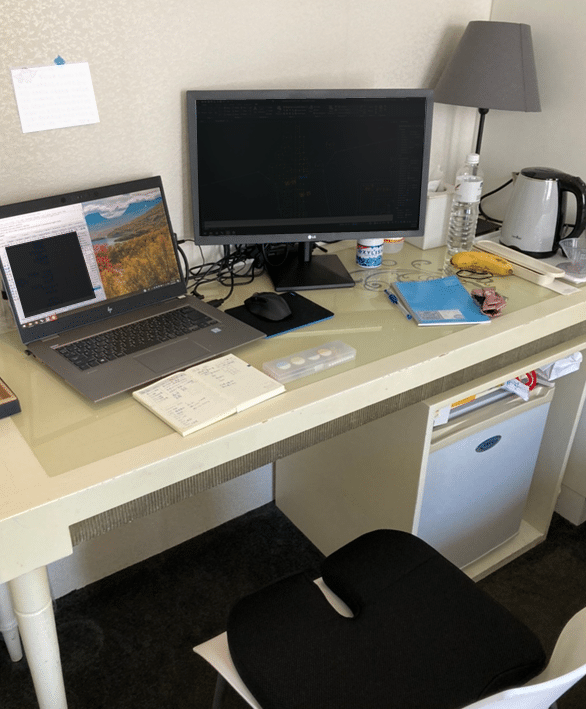How is working remotely from Taiwan?
This is Iris. I work for Syntegrate Japan, I have chances to work remotely from not only Japan but Taiwan. Due to the Covid19, the company initiated remote working in March 2020, and I can see the difference between Japan and Taiwan while I worked remotely in Taiwan under the Covid19 era.
I will write about the process of entering Taiwan, the survival story during the mandatory quarantine period, and maintaining the working pace. I like to share my feelings and activities during work from the home in Taiwan.
Editor’s Note: Due to the coronavirus epidemic, Syntegrate has started remote work since March 2020, creating an environment where all employees can work from home (Only the company president has been in the office all the time, the office space makes him calmer). The related detail also being mentioned in the second half of this article, but I would like to make more detail about the start point.
After Entering Taiwan


Under this global epidemic, entering Taiwan or other countries has been difficult. Taiwan requires two weeks of quarantine and a week of household isolation. This means I have to stay in an epidemic-prevention hotel for two weeks and stay at home for a week. So, before my arrival in Taiwan, I had to reserve my future prison (the hotel) with windows and everyday meals.
Everyone might have heard that Taiwan has strict rules for travelers. As a Taiwanese, I have prepared for all these issues, but what I didn’t expect was the “alcohol shower”. Just like the shower before entering the pool, the airport staff sprays the alcohol all over you. After leaving the gate (at the airport), no matter where you are or what you touch, an alcohol shower comes with it. Seriously, I had a moment to worry that I might get burned from this.
(Editor’s Note: Here is the disinfection of Taoyuan International Airport. You can see that the staff is spraying alcohol on the suitcase, but she said that the staff was doing almost the same for people. I wonder if it makes sense …)
In Taiwan you are not allowed to use public transportation, the only way was to take the epidemic-prevention taxi. (Not expensive, an hour ride only charged for 3000-3500 yen) After checking in the hotel, I officially started my quarantine. I was not allowed to get out of the room and given the everyday meals which were put outside the door by the hotel. Therefore, the image of my hometown for the first month is almost the window view. After work or noon break, the Taiwan 34-degree weather with the sun and the humid wind goes through the window to remind me where I was.

People might wonder what was the work conditions different between Taiwan and Japan. But beyond the work itself, the first two weeks for me, the differnece was the space arrangement. The hardest thing to start remote working might be the working desk setting. Considering the nature of my work, I ordered a new monitor, internet cable, and a cushion soon after I arrived at the hotel. It was lucky that Japan and Taiwan have only one hour of jet lag to adapt.
The daily working schedule was similar to the time in Japan, which allowed the meeting to go smoothly, just the physical atmosphere was hotter weather and more isolated. You would not get bothered by anyone during the quarantine, you were more willing to work because you have nothing else to do. During the weekend or after work, you had plenty of time to learn something.
For me, I studied the python script, language practice, and simple indoor exercises to keep healthy in both mental and physical. I believe there are rare occasions in life to have this kind of experience. On the other hand, it is very convenient to order any food or drink from Ubereats, Foodpanda in Taiwan. The things including Tapioca, fresh fruits, and even night market food. My biggest concern during the quarantine was controlling my weight and stay in healthy.
Working In Taiwan

When I completed my quarantine, the corona situation got worsen in Taiwan. The Government lockdown all the entertainment venues, wearing masks is compulsory everywhere. The non-working indoor activity over five persons was not allowed. People were panicking like everyone else in the world last year. They could not have the party; the restaurant could only serve take-out. Apparently, my quarantine suddenly became everyone’s isolation. Under this situation, I finally arrived at my home.
At home, the new challenge was to balance personal time and working hours. In Japan, most people live alone, not with family. But in Taiwan, it is normal to live with the family. The working schedule was not only shared with your co-worker but also with your family.
Since I started remote work last year, when shifting the work to another country, besides jet lag, working-space problems, and physical issues, I found that the issues of remote working mostly happened in trust and communication. I could barely tell the difference between the routine work conditions between Japan and Taiwan. It is the “remote working” concept itself that brings diversity. It brings the chance to consider the flexibility of work, intentional communication, and efficient negotiation.
Taiwan and Japan both suffered at the turning point of working style changing. To redefine the management system, companies require managers to set clear goals for employees, trust their members, and encourage them to aim in the same direction. In addition, this system gives the possibility for multinational workers to enjoy family time while chasing their careers.
There are pros and cons for companies and employees. What we can do is find a way to adapt to this change to keep productivity and lifestyle at the same time. So, here’s how I deal with remote working for the next chart.
How to make remote work easier – From company view

Imagine you are walking into the office, you say hi to your co-workers, your manager, and your boss. You dress well, speak quietly, you devote yourself to the official, public space to convince yourself where you are, who you should be, and what you need to do. We define ourselves with environmental feedback. The working desk’s shape, the walking sound, other people’s discussion will naturally imply to you how to continue the performance of the work. When these were cut out from daily life, people might feel confused about what happened to the lost environment memory from the office to home working desk. We feel frustrated for lacking feedback, connection.
When talking about this change, my friends who work in different fields of tech companies in Taiwan, Hong Kong, and the USA talked about the condition change and how to deal with remote working. We discovered that whether to work from home or the office, the problems are almost the same.
In fact, whether working remotely or transnationally, new problems are not created, but the original management details were enlarged. While working remotely or even transnationally, it emphasizes more communication skills and self-management processes. People need to focus more on the working process to ensure the team members are on the same page.
For this intention, Syntegrate used multiple online work platforms such as Trello, ClickUp, zoom, and Slack which make the reminder, workflow, and discussion more open. The online tools are meant to ensure that individual and team goals and responsibilities are clear.
The diversity of platforms offer different playbooks for communication and meeting. They are like guidelines for different purposes. As a quick question could be done by Zoom, the discussion could be held on Slack. The record and issue tracking became easier. Through the last year of the try-out for remote work, we gradually built the system to turn the office daily work into a working principle to support everyone in the company. It is not done by a person, but the organization’s trial to adapt to the new way of this turning point.
How to make remote work easier – From personal view

The system change will also reflect on the personal adapting. For the discussion and the personal experience, I can roughly divide it into the following points:
1. Set the working area.
The space setting might be the most important thing to make you feel like working. To shift the mood for work, I minimized the working area layout to assemble the equipment everywhere. The pros are that you can clarify the time and mind of the job. The bad part is that you might not want to pass or even sit there after work. It could be the first step for people to regain the power of their own life by considering the space arrangement.
2. Record the working condition and schedule.
Every in the morning, each team have a meeting to discuss the daily goal and tasks, the record I made is furthermore to monitor my long-term working condition. I set two charts for “today’s task” and “the priority list”, which could be done with the task management online platform.
3. To self-monitor, but stay honest for the record.
Everyone should find their own way of self-recording, my record was mainly to note my task working time, results, and mistakes. To know each working period’s efficiency to decide the priority of the task, check back workflow. I could find Everyone should find their own way of self-recording, my record was mainly to note my task working time, results, and mistakes. To know each working period’s efficiency to decide the priority of the task, check back workflow. I could find the best time for writing code, which time will be good for checking model details. In order to know that, the record requires to be self-honest. To recognize my condition, the blood sugar ratio, the caffeine….anything to affect your working performance. The record offers the possibility to push yourself away from negative effects for working with self-confidence.
4. Keep communicating with a colleague for help and questions with being prepared.
Working remotely should encourage people to be positive, to be compassionate. Without face-to-face, the question of software, modeling, data might be difficult to describe. People were hard to guess the potential issue through simple words. Therefore, the question should testify and being record as material for discussion. This might take more time first, but it is also training for being meticulous.
5. Set the daily conclusion of the work and work plan for tomorrow.
According to the statistics of Atlassian’s collaborative services such as Jira, Confluence, and Bitbucket provided by them. The work remotely has also further blurred the line between people’s work time and personal time. Remote work under these circumstances is alone. Having a conclusion of one day of work not only serves for company KPI but to set a switch to reward yourself. People might feel anxious for not having feedback for what has been done. One step at a time set a small goal for the mountain steps. In which to encourage yourself and your team for the right path.
Postscript: I have come back from July and to be in quarantine for two weeks in Japan. Syntegrate still keeps remote work and maintains flexible office days accordingly.
Reference
- Proof our work-life balance is in danger (but there’s still hope) https://www.atlassian.com/blog/teamwork/data-analysis-length-of-workday-covid
- This is how to safeguard your mental health when you’re (still) working from home https://www.atlassian.com/blog/productivity/work-from-home-mental-health
- Why Remote Work Makes Teams (And Leaders) Better https://www.entrepreneur.com/article/351142